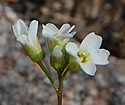Draba reptans (Carolina Whitlow-grass)
| Also known as: | Carolina Draba |
|---|---|
| Genus: | Draba |
| Family: | Brassicaceae (Mustard) |
| Life cycle: | annual |
| Origin: | native |
| Habitat: | sun; dry sandy or rocky soil; prairies, rock outcrops, roadsides |
| Bloom season: | April - May |
| Plant height: | 2 to 10 inches |
| Wetland Indicator Status: | none |
| MN county distribution (click map to enlarge): |  |
| National distribution (click map to enlarge): |  |
Pick an image for a larger view. See the glossary for icon descriptions.
Detailed Information
Flower: 

![[photo of flowers]](/udata/r9ndp23q/white/carolina-whitlow-grass-d-reptans_0506_113138-t.jpg) Tight cluster of up to 12, smooth-stalked flowers at the tip of the stem. Flowers are 1/3 inch across with 4 white petals, rounded or with a small notch at the tip, and 6 yellow stamens. Later in the season, tiny petal-less, self-pollinating (cleistogamous) flowers are produced. Unlike many members of the mustard family, the flowering clusters do not elongate with maturity.
Tight cluster of up to 12, smooth-stalked flowers at the tip of the stem. Flowers are 1/3 inch across with 4 white petals, rounded or with a small notch at the tip, and 6 yellow stamens. Later in the season, tiny petal-less, self-pollinating (cleistogamous) flowers are produced. Unlike many members of the mustard family, the flowering clusters do not elongate with maturity.
Leaves and stems: 


![[photo of leaves]](/udata/r9ndp23q/white/carolina-whitlow-grass-d-reptans_0506_113327-t.jpg) Leaves are mostly basal, 1/5 to about 1 inch long and about half as wide, spatula-shaped to oval with rounded tips, toothless, short-stalked to stalkless. Surfaces are dimpled with branching hairs. Stem leaves are not common, but when they occur are similar to basal leaves and clustered near the base of the stem. Stems are wiry, typically purplish, unbranched or branched from the base, densely hairy at the base, becoming hairless above the leaves and into the flowers.
Leaves are mostly basal, 1/5 to about 1 inch long and about half as wide, spatula-shaped to oval with rounded tips, toothless, short-stalked to stalkless. Surfaces are dimpled with branching hairs. Stem leaves are not common, but when they occur are similar to basal leaves and clustered near the base of the stem. Stems are wiry, typically purplish, unbranched or branched from the base, densely hairy at the base, becoming hairless above the leaves and into the flowers.
Fruit: 
![[photo of fruit]](/udata/r9ndp23q/pd/draba-reptans-77928-3-t.jpg) Fruit is a flattened pod 3/8 to ¾ inch long and about 1/8 inch wide, held erect to ascending on a short stalk, and may be covered in short hairs pressed close to the surface (appressed). The array of fruit resembles a candelabra.
Fruit is a flattened pod 3/8 to ¾ inch long and about 1/8 inch wide, held erect to ascending on a short stalk, and may be covered in short hairs pressed close to the surface (appressed). The array of fruit resembles a candelabra.
Notes:
While not considered a rare species in Minnesota, this one is not so easily found, as its diminutive size and short blooming period makes it an easy one to miss—blink and it's gone! We tried known locations for a few years and were always either too early or too late for the blooms but luck was on our side in spring of 2013 when we came upon a small population in full bloom in Renville County. Of the 4 other whitlow grasses present in Minnesota, Draba reptans most closely resembles D. cana (Hoary Whitlow-grass) and D. norvegica (Norwegian Whitlow-grass), both endangered species found in only a few locations in NE MN, primarily in Cook County. While the leaves of D. reptans are similar to D. nemorosa (Yellow Whitlow-grass), that species is easily differentiated by its yellow flowers and elongating stems.
Native Plant Nurseries, Restoration and Landscaping Services ↓
More photos
Photos by K. Chayka and Peter M. Dziuk taken at a roadside outcrop in Renville County.
Comments
Have you seen this plant in Minnesota, or have any other comments about it?
on: 2018-04-27 19:20:56
Blooming today - so perfect. Read the passage on this plant in the April chapter in A Sand County Almanac - a very lovely commentary on a small and often overlooked flower.
on: 2018-07-28 09:41:33
Blooming today - so perfect. Read the passage on this plant in the April chapter in A Sand County Almanac - a very lovely commentary on a small and often overlooked flower.
on: 2024-04-11 12:35:23
Blooming 4/10/24 at Nine Mile Creek Prairie in Bloomington! Never saw any of these before in all the years I've gone there to see pasque flowers.







 Carolina Whitlow-grass plant, with Western Androsace
Carolina Whitlow-grass plant, with Western Androsace